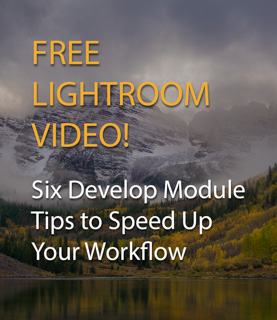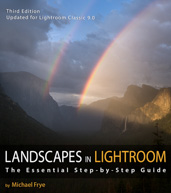In the Moment:
Michael Frye's Landscape Photography Blog
by Michael Frye | Aug 15, 2012 | Announcements, Workshops
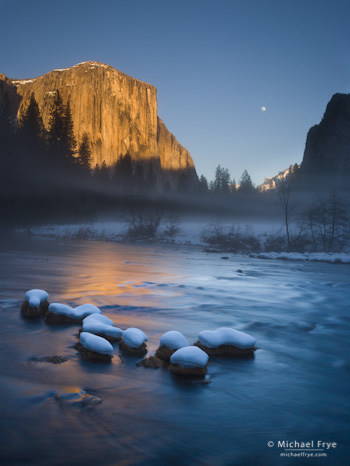
A January moonrise from Valley View, Yosemite
The Ansel Adams Gallery recently announced their 2013 workshops. I’m pleased to be teaching four Yosemite photography workshops for the Gallery next year—Landscapes in the Digital Darkroom: Mastering Lightroom (January); Spring Yosemite Digital Camera Workshop (April); Hidden Yosemite (July); and The Digital Landscape: Autumn in Yosemite (October).
As many of you know, I’m a big fan of Lightroom because it’s simple, yet powerful—easy to use, but sophisticated enough to get great results with almost any image. Last January was the first time I taught a workshop specifically focused on this tool: Landscapes in the Digital Darkroom: Mastering Lightroom. This class was popular, and a lot of fun, so we’ll be doing it again next January. Of course it’s not all computer work—the workshop includes field sessions to photograph snowy January landscapes, the rising full moon, and, if we’re lucky, clearing storms. I’m really looking forward to it!
The other three workshops—Spring Yosemite Digital Camera Workshop, Hidden Yosemite, and The Digital Landscape—have been very popular in the past, and sometimes fill quickly, so be sure to reserve space early.
And stay tuned… I’ll be announcing more workshops within the next month.
(more…)
by Michael Frye | Aug 8, 2012 | Critiques
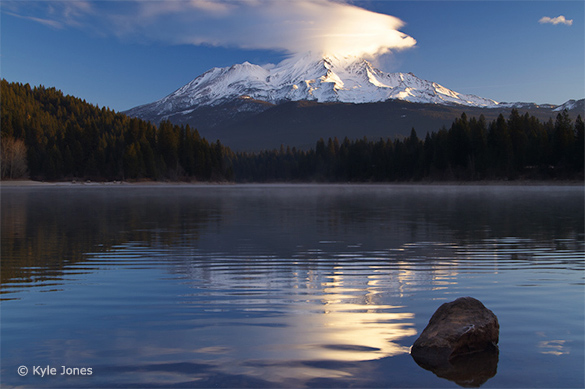
Mt. Shasta and Lake Siskiyou by Kyle Jones
I know it’s been awhile since the last critique; it’s been hard to find the time lately. But many of you have told me how much you like the critiques, and I really appreciate that, and I’m happy to have the opportunity to do another one. I’m writing this critique, rather than doing it by video, because, well, it’s just easier. But I may still do video critiques again in the future.
The subject of this critique is a photo by Kyle Jones called “Mount Shasta and Lake Siskiyou,” from the far northern reaches of California. I think this image has some interesting things to teach us about space and separation in a composition, and shutter speeds for water.
(more…)
by Michael Frye | Jul 31, 2012 | Announcements
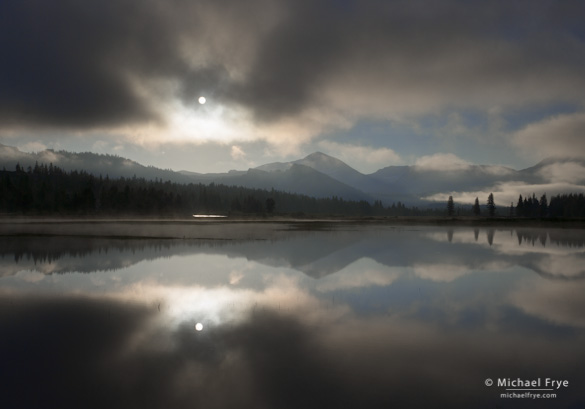
Sun breaking through Mist, Tuolumne Meadows—the opening image for Chapter 4 of the book
Since I wrote my last post about the new edition of The Photographer’s Guide to Yosemite I’ve had several people ask me whether the iPhone/iPad app will be updated as well. Sorry that I wasn’t clear about this: the app is already updated, and has been since it first came out last year. The new locations, information, and tips about digital photography went into the app first, and are now coming out in book form. It takes a lot longer to get a book to press than to make an app!
Not only does the app have all the information that’s in the new edition of the book, but it has functions that you can’t put into a book, like the ability to view only the best locations for a particular month and time of day. Of course many people prefer to hold a physical book in their hands, and I completely understand that. I’m sure some people will get both—the app for its convenience and portability, the book for more leisurely browsing. I’m completely okay with that. 🙂
—Michael Frye
Related Post: The New Edition of The Photographer’s Guide to Yosemite is Here!
Michael Frye is a professional photographer specializing in landscapes and nature. He is the author and photographer of The Photographer’s Guide to Yosemite, Yosemite Meditations, and Digital Landscape Photography: In the Footsteps of Ansel Adams and the Great Masters, plus the eBooks Light & Land: Landscapes in the Digital Darkroom, and Exposure for Outdoor Photography. He has written numerous magazine articles on the art and technique of photography, and his images have been published in over thirty countries around the world. Michael has lived either in or near Yosemite National Park since 1983, currently residing just outside the park in Mariposa, California.
by Michael Frye | Jul 30, 2012 | Announcements
 The new edition of The Photographer’s Guide to Yosemite is finally here! You can order signed copies directly from me, get it from the publisher, Yosemite Conservancy, or find it in the park at The Ansel Adams Gallery or Valley Visitor Center. It will be also available from Amazon soon.
The new edition of The Photographer’s Guide to Yosemite is finally here! You can order signed copies directly from me, get it from the publisher, Yosemite Conservancy, or find it in the park at The Ansel Adams Gallery or Valley Visitor Center. It will be also available from Amazon soon.
The new edition has three new locations, and completely revised and updated information for the entire park. You’ll find new tips specifically designed for digital photography, including Digital Camera Settings, White Balance, Exposure, and HDR and Exposure Blending, plus Depth of Field, Filters, Night Photography, and much more. Most of the 100+ photographs are new too, and the reproductions are excellent—a pleasant surprise for an inexpensive guidebook.
Of course if you prefer the convenience of having all the information in your smart phone or tablet, everything that’s in the new book is also in the iPhone and iPad app.
Thank you all for your patience! I hope you like this new edition even more than the original.
—Michael Frye
Related Posts: New Edition of The Photographer’s Guide to Yosemite: It’s Almost Here!; The Photographer’s Guide to Yosemite iPhone App is Available Today!
Michael Frye is a professional photographer specializing in landscapes and nature. He is the author and photographer of The Photographer’s Guide to Yosemite, Yosemite Meditations, and Digital Landscape Photography: In the Footsteps of Ansel Adams and the Great Masters, plus the eBooks Light & Land: Landscapes in the Digital Darkroom, and Exposure for Outdoor Photography. He has written numerous magazine articles on the art and technique of photography, and his images have been published in over thirty countries around the world. Michael has lived either in or near Yosemite National Park since 1983, currently residing just outside the park in Mariposa, California.
by Michael Frye | Jul 26, 2012 | Workshops
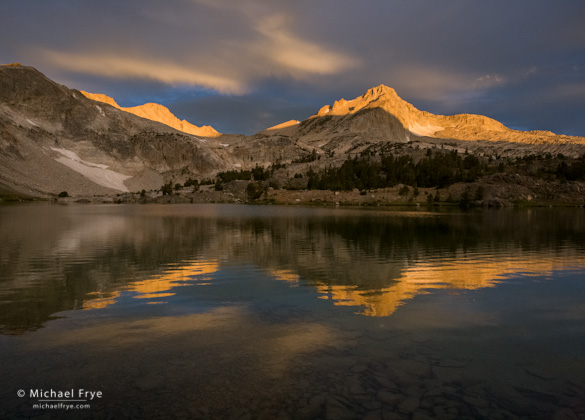
Sunrise illuminates North Peak. I like the rippled reflection, preserved by a fast shutter speed (1/90th sec).
Teaching my Hidden Yosemite workshop last week was so much fun. We had some wonderful clouds to make the skies more interesting, and a great group of people, plus it’s always fun to get away from the roads and into some beautiful areas that you just can’t drive to.
Weather forecasts before the workshop called for clear skies, but our first evening we photographed some amazing lenticular clouds, including two UFO disks over Mammoth Peak, and another formation to the north resembling an Imperial Star Destroyer. Later in the week the sun broke through overcast skies just before sunset and lit up the clouds over Gaylor Lakes, and the next morning we watched sunlight poke through more clouds to illuminate North Peak. And then it snowed. Meteorologists try to predict the future, which is a difficult job. This is one time when I’m glad they were wrong—the clouds definitely made things more interesting.
(more…)
by Michael Frye | Jul 10, 2012 | Announcements
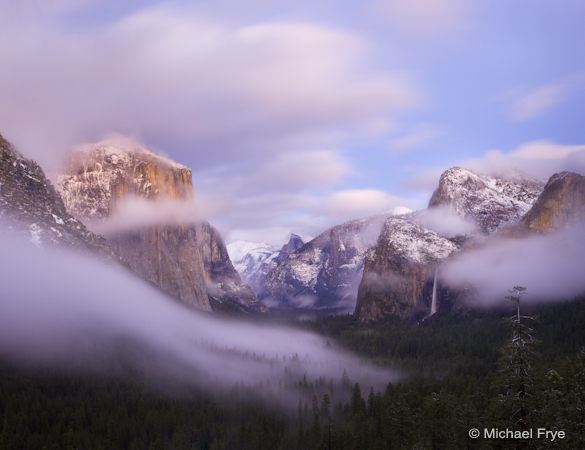
Clearing storm, dusk, Tunnel View, Yosemite NP, CA, USA
I’ll be a guest today on TWiT Photo, the highly-entertaining internet TV show hosted by Catherine Hall and Leo Laporte. You can view the live recording at 1 p.m. Pacific time, or download the video later in the day. Hope you get a chance to watch!
— Michael Frye
Michael Frye is a professional photographer specializing in landscapes and nature. He is the author and photographer of The Photographer’s Guide to Yosemite, Yosemite Meditations, and Digital Landscape Photography: In the Footsteps of Ansel Adams and the Great Masters, plus the eBooks Light & Land: Landscapes in the Digital Darkroom, and Exposure for Outdoor Photography. He has written numerous magazine articles on the art and technique of photography, and his images have been published in over thirty countries around the world. Michael has lived either in or near Yosemite National Park since 1983, currently residing just outside the park in Mariposa, California.
by Michael Frye | Jun 29, 2012 | Announcements, Yosemite Photo Conditions
 Many people have been asking me when the new edition of The Photographer’s Guide to Yosemite will be available. Well as I write this an actual, real, physical copy is sitting on my desk. It’s an advance copy, which means it was shipped by air—the rest are on a boat from China, and should be here and on bookshelves in about a month. So the wait is almost over!
Many people have been asking me when the new edition of The Photographer’s Guide to Yosemite will be available. Well as I write this an actual, real, physical copy is sitting on my desk. It’s an advance copy, which means it was shipped by air—the rest are on a boat from China, and should be here and on bookshelves in about a month. So the wait is almost over!
The new edition has three new locations, and completely revised and updated information for the entire park. You’ll find new tips specifically designed for digital photography, including Digital Camera Settings, White Balance, Exposure, and HDR and Exposure Blending, plus Depth of Field, Filters, Night Photography, and much more. Most of the 100+ photographs are new too, and the reproductions are excellent—a pleasant surprise for an inexpensive guidebook.
Of course I’ll let you know when the book goes on sale. And if you can’t wait, or prefer the convenience of having all the information in your smart phone or tablet, all the information in the new book is in the iPhone and iPad app.
Thanks to all of you who have purchased The Photographer’s Guide to Yosemite over the years. So many people have taken the time to let me know how much they love the book, and I really appreciate that. I hope you’ll like the new edition just as much!
A Note to Subscribers
I’m using a new service (AWeber) to send out blog subscriptions, so if you subscribe to this blog by email you might notice that the format looks a little different when you view this post in your inbox. You don’t need to do anything; if you already subscribe you’ll continue to get the posts by email. Thank you so much for subscribing!
—Michael Frye
Related Posts: The Photographer’s Guide to Yosemite iPhone App is Available Today!; The iPad Version is Here!
Michael Frye is a professional photographer specializing in landscapes and nature. He is the author and photographer of The Photographer’s Guide to Yosemite, Yosemite Meditations, and Digital Landscape Photography: In the Footsteps of Ansel Adams and the Great Masters, plus the eBooks Light & Land: Landscapes in the Digital Darkroom, and Exposure for Outdoor Photography. He has written numerous magazine articles on the art and technique of photography, and his images have been published in over thirty countries around the world. Michael has lived either in or near Yosemite National Park since 1983, currently residing just outside the park in Mariposa, California.
by Michael Frye | Jun 26, 2012 | Vision and Creativity, Workshops

Bristlecone pine snag at night with star trails, White Mountains
Night photography offers wonderful opportunities to be creative. The low light allows you to use long exposures to record movement, like star trails or moonlit clouds. And since the natural light is so dim, you can easily overpower it with a flash or flashlight and add your own light to a scene.
That aspect of night photography—light-painting—has intrigued me for a long time. Adding your own light to a nighttime scene gives it a new dimension; it instantly transforms the landscape into something different, something we never see in real life, and adds a mysterious, surreal element to the photograph.
The accompanying image has both movement, in the form of star trails, and light-painting. I used a flashlight to trace the branches of this bristlecone pine snag, then painted zig-zag lines over the rocky foreground. I made this photograph with medium-format film back in September of 2000. Some test exposures with a Polaroid back helped me get the light-painting right, then I switched to real film (probably Provia), did the light-painting again, and then left the shutter open for another 90 minutes to record the star trails. You can see more examples of my light-painting techniques in my nighttime portfolio.
I learned light-painting with film, which was a slow trial-and-error (mostly error) process. Digital cameras make the learning curve much easier, because you can experiment and see the results immediately. If you’ve never tried night photography before this might be a fun summertime project—a way to stretch yourself a little and exercise your imagination. Summer is a great season for photographing landscapes at night, since the Milky Way is prominent, and the warm nighttime temperatures make it more comfortable to stay out late.
Whether you’re an experienced night photographer or a beginner, I recommend reading Lance Keimig and Scott Martin’s excellent book Night Photography: Finding Your Way in the Dark. Also, you can find tips about focus and exposure for moonlit landscapes in my post about photographing lunar rainbows.
And if you prefer hands-on learning there’s still space in my Full Moon Night Photography workshop later this summer (July 31st and August 1st). This is a great way to get personalized instruction and learn night photography in a fun, supportive group atmosphere. Rooms have been set aside for this workshop in Yosemite Valley and are still available if you register soon.
—Michael Frye
Related Posts: Under the Full Moon; Tips for Photographing Lunar Rainbows; Also, see images made by participants in last year’s night photography workshop in this Flickr group
Michael Frye is a professional photographer specializing in landscapes and nature. He is the author and photographer of The Photographer’s Guide to Yosemite, Yosemite Meditations, and Digital Landscape Photography: In the Footsteps of Ansel Adams and the Great Masters, plus the eBooks Light & Land: Landscapes in the Digital Darkroom, and Exposure for Outdoor Photography. He has written numerous magazine articles on the art and technique of photography, and his images have been published in over thirty countries around the world. Michael has lived either in or near Yosemite National Park since 1983, currently residing just outside the park in Mariposa, California.
by Michael Frye | Jun 20, 2012 | Vision and Creativity
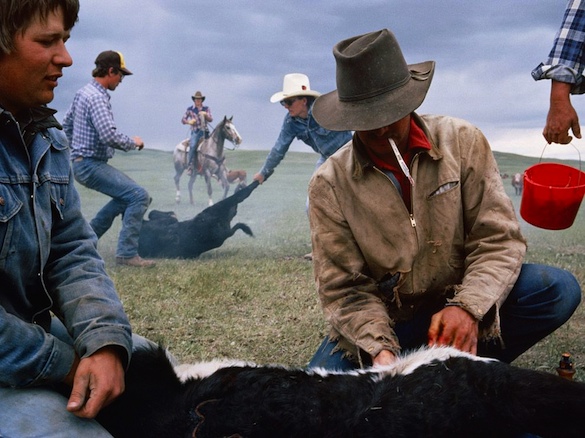
Sam Abell’s classic image of cowboys castrating cattle in Montana
It’s not often that you get to hear a master photographer explain how he made one of his greatest images, so I was thrilled to find this short video of Sam Abell describing how he made his classic photograph of cowboys branding cattle in Montana.
I love this statement: “What we’re all trying to do is make a layered, deep, complex, complicated photograph that doesn’t look complex or complicated.”
In talking about composition in my workshops and books I emphasize simplicity, since I think the single most common mistake people make is including too much in the frame. But my favorite images are rich and complex, without crossing the line into being busy and confusing. Obviously it takes years of experience to be able to make photographs like that – and Abell’s experience and mastery are on full display in this image.
(more…)
by Michael Frye | Jun 15, 2012 | Digital Darkroom
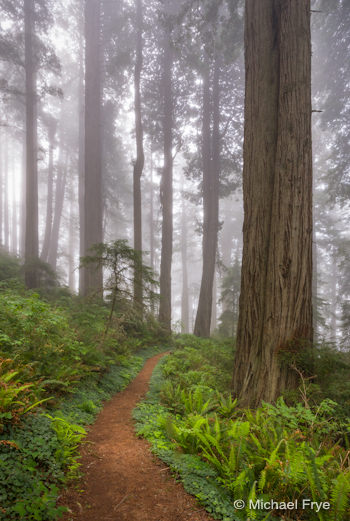
Path through foggy redwoods
I meant to post this earlier, but if you haven’t heard, Lightroom 4.1 was officially released about two weeks ago. So if you’ve been waiting to upgrade to Lightroom 4 until Adobe fixed the bugs, I think your wait is over, as the major problems should have been addressed. I know the point curve bug was fixed with the 4.1 RC (“release candidate”), so that shouldn’t be an issue any more.
Lightroom 4 is a big step forward in Raw image processing, but the advancements require a lot of horsepower to work properly. So check the system requirements before you take the plunge. Many people have had to upgrade their operating system to run Lightroom 4, and upgrading your OS can be a big undertaking, requiring that you update other applications as well.
Earlier I posted two videos about Lightroom 4, so if you haven’t watched those yet they can help you get up to speed in the new process. Here are links to Part 1 and Part 2.
The first image here, as well as all of the images from Monday’s post—including some pretty high-contrast scenes—were processed exclusively in Lightroom 4. In the comments for that last post JayM asked if I could make a tutorial on how I processed the first image. That’s a great suggestion, but for now you’ll find a screen shot below that shows the Basic Panel settings for that photograph. (I didn’t use the Tone Curve, which is not unusual for me these days with high-contrast images in Lightroom 4.)
(more…)










